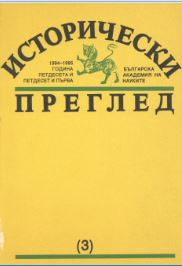Унгария и българските земи под византийска власт ХI–ХII век
Hungary and the Bulgarian Lands under Byzantine Rule (11th – 12th c.)
Author(s): Christo DimitrovSubject(s): History, Political history, Middle Ages, 6th to 12th Centuries
Published by: Институт за исторически изследвания - Българска академия на науките
Summary/Abstract: The contacts of the Bulgarians with Hungary in the 11th and 12th centuries affected mostly the population of the towns of Branichevo, Belgrade and Srem and their districts, and to a lesser extent also the districts of Vidin, Nish, Sofia and Macedonia. The information about the Vardariot-Turks in one of the characters of Basil II probably reflects the position of the Hungarian settlers in the valley of the river Vardar who accepted the Orthodox faith and were obliged by virtue of that to pay canon icon to the Archbishop of Oh rid and to serve as mercenaries in the troops of the Byzantine Emperor. The Bulgarians were linked to Hungary, although indirectly, by the personality of Peter Delyan who besides being of half-Hungarian origin, prior to having been crowned as Bulgarian King, probably bore the title of "Ban" in court of the Hungarian King, and perhaps occupied some position in the central or local administration of Hungary. In 1059 the Magyars launched a campaign against Byzantium, advancing deeply southeast, reaching Sofia. There the Emperor Isaac I Comnenus achieved the renovation of the peace treaty between the two countries, after which their armies withdrew. In 1068 the Hungarian King Solomon attacked Srem but the local Bulgarians and the Byzantine garrison succeeded in warding him off. Some link is possible between the Hungarian attack on Belgrade in 1072–1073 and the second big uprising of the Bulgarians against Byzantium, headed by Georgi Voiteh and Constantine Bodin. In 1087 Solomon again attacked with the help of the Kumans the Bulgarian territories of Byzantium, but the attack was repulsed by the imperial troops. Relations between Hungary and Byzantium strained again at the end of the twenties of the 12th c. In 1127 the Magyars seized and ravaged Belgrade, Branichevo, Nish and Sofia. The next year the military operations were fought across the Sava and Danube riv,3rs, but in 1129 Branichevo was again occupied and burnt down. Some twenty years later this town still not recover economically - it was in a rather wretched state when through it passed the Second Crusade (1147–1148). In 1150–1155 took place the first stage of the great war the Emperor Manuel I Comnenus fought against Hungary. Again the Bulgarian North-West was the most badly affected. Particular attention, however, deserve the report on the anti-Byzantine uprising of the Bulgarians in Belgrade who benefited from the military operations of the Magyars against the Empire. In the second stage (1162–1167) they were chiefly fought across the Danube and Sava, but the Bulgarian population continued to live under the threat of the Magyar attacks and in point of fact again bore the brunt in achieving the Byzantine triumph over Hungary.
Journal: Исторически преглед
- Issue Year: 1995
- Issue No: 3
- Page Range: 3-18
- Page Count: 16
- Language: Bulgarian
- Content File-PDF

